Day 1 of a three day, small group, socially-distanced Early Autumn Tour in Norfolk. It was mostly cloudy, with a fresh SW breeze, but warm and most importantly it stayed dry for us, a nice day to be out again.
We started the day at Wells. As soon as we got out of the minibus, we could see Spoonbills at the back of the pool off to the right. There were seven of them at first – five were standing together in the water, mostly asleep (which is what Spoonbills generally seem to spend most of their time doing!), but two were awake. One was walking round after the other bobbing its head up and down – one of this year’s juveniles still begging its parent relentlessly to be fed.
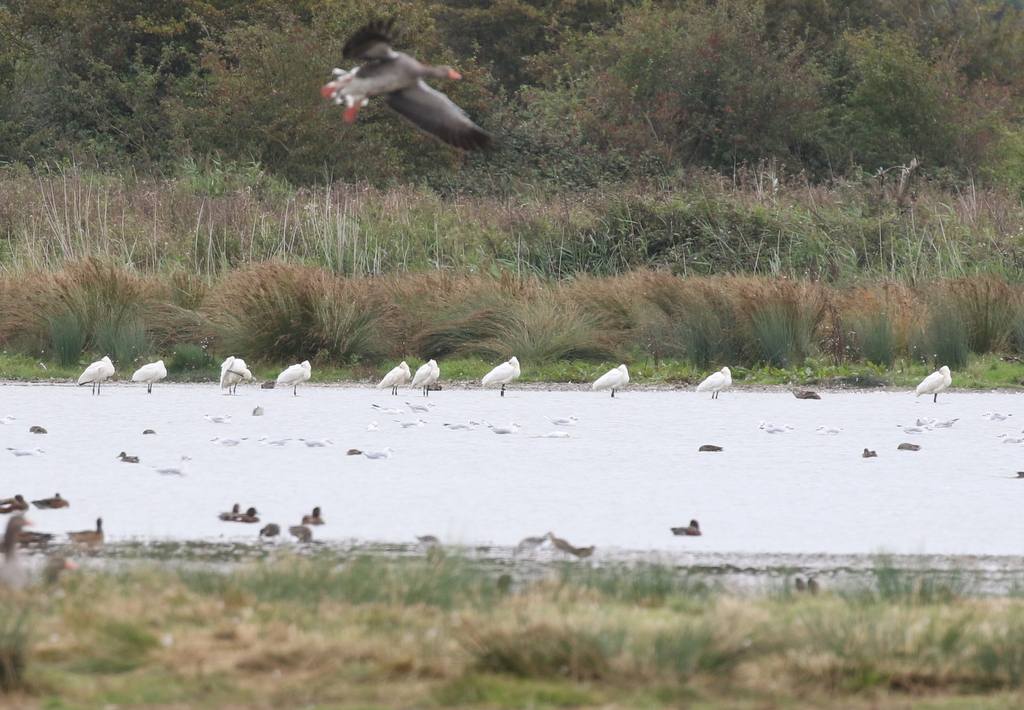
There was lots of wildfowl on the same pool too, masses of Greylag Geese with a good number of Canada and Egyptian Geese thrown in too. This is not the time of year to admire ducks, with the drakes currently in their drab eclipse plumage, but there were plenty of Wigeon and Teal, plus a few Shoveler and a single Pintail right over at the back.
We could see a good selection of waders too, with particularly good numbers of Ruff. A small group of juvenile Ruff, in shades of tawny, brown and buff, were feeding on a muddy pool close to the track a bit further up, whereas the grey and white adults were further out in the middle.
Across the other side of the track, the pool is slowly drying out and a Green Sandpiper was feeding out in the middle of the wet mud. We got it in the scope and a Wood Sandpiper appeared alongside, giving us a nice comparison. We could see the latter’s better-marked white supercilium and the more prominent pale spotting on its upperparts.

A few Pheasants were in the field next to where we had parked, which had recently been cultivated. A Stock Dove flew in and landed with the Woodpigeons, giving us a nice side by side comparison.
As we set off down the track, we met someone coming back the other way who told us they had seen a Spotted Redshank on the pool earlier. We stopped for another scan, but couldn’t see it anywhere. Another Green Sandpiper was now down with the juvenile Ruff much closer to us now. A Marsh Harrier was down in the grass at the back of the pool, which we got in the scopes as it had a quick fly around. The Spoonbills had multiplied too, up to ten now.
As we started walking again, the Spotted Redshank flew up from behind the vegetation at the far side, alerting us with its distinctive ringing ‘tchewitt’ call. It flew across the track ahead of us, showing off the ‘cigar’ of white up its back, and lack of white in the wing versus its commoner cousin. We could see it was a dusky grey juvenile as it dropped down behind the vegetation along the channel the other side. From further up, we could only just see it through the tall grass.
Continuing on past the pools, we came out into the area of open bushes beyond. There were lots of small birds flitting about here, with a nice selection of warblers including several Blackcaps, Common Whitethroats and one or two Lesser Whitethroats. A Reed Warbler called from the reeds behind us and another appeared in the bottom of the bushes.
We could hear Greenfinches and one or two Chaffinches calling and lots of Goldfinches which kept flying back and forth between the bushes. Round by the seawall, there were several Reed Buntings and Yellowhammers in with them too. One or two of the latter perched up on top long enough for us to get a better look at them.

Peering over the reeds towards the westernmost pool, a Kingfisher shot past over the ditch in front of us in a flash of electric blue. We could see more waders on the pool here. A couple of Common Snipe were tucked under the vegetation on the bank at the back, and two Common Sandpipers were running around on the mud. A Greenshank was asleep in the far corner with yet another Green Sandpiper working its way along the bank beyond.
Lots of Black-headed Gulls were dropping in to the shallow water to drink and preen. Scanning across through them, we noticed one with pure white wing tips, not black like the Black-headed Gulls. When it turned round, we could see it had a heavier, brighter red bill too, and a more of a black bandit mask rather than a distinct black spot behind the eye. It was an adult Mediterranean Gull in non-breeding plumage, already having moulted out its summer black hood.
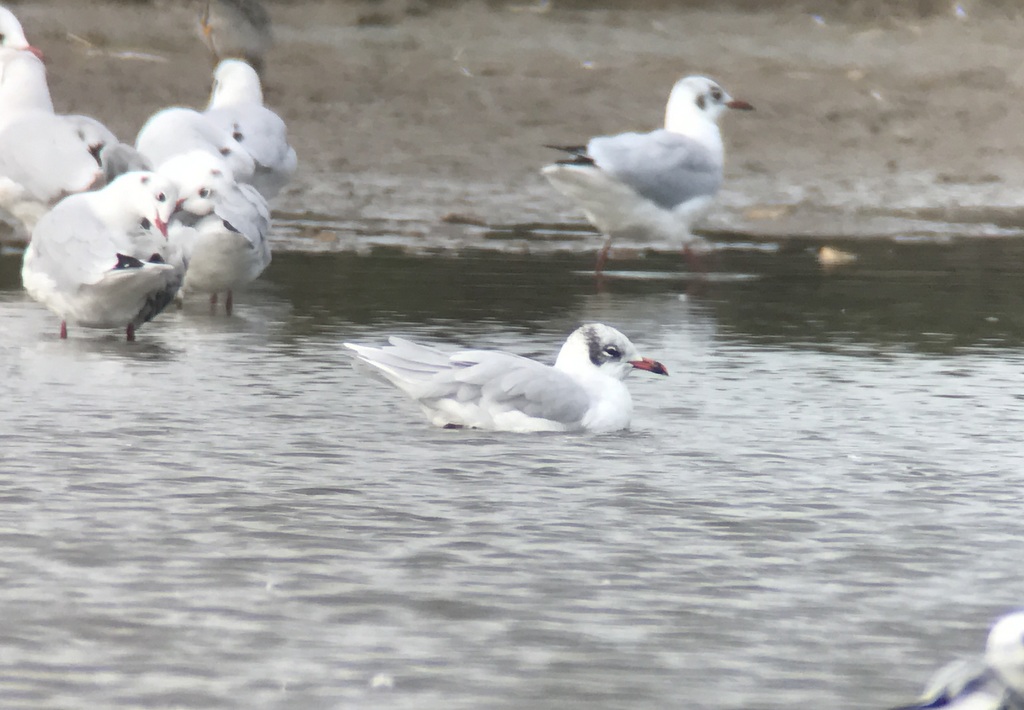
From up on the seawall, we had a wider view of more of the pool. From here, we could get a better look at the plovers which had appeared from behind the grass at the back. Three Little Ringed Plovers were feeding on the mud alongside two Ringed Plovers, the latter distinctly larger, and bigger-headed with more distinct black and white rings round. There were three Dunlin with them too.
From up on the seawall, it was high tide out in the harbour. We could see a few Curlew, Redshanks and Oystercatchers roosting out in the vegetation on the saltmarsh. A Common Sandpiper flew over the water and landed on the support of an old bridge which has long since washed away. A couple of Common Buzzards circled high out towards the beach and drifted off west, and a distant Marsh Harrier was hunting the dunes.
There were a few hirundines on the move this morning, small groups making their way west, mainly Swallows and House Martins. A group of Swallows stopped to hawk over the grassy fields beyond the pools for a while. We picked up a couple of Common Swifts on their way west too. Most of them have already left us, and there are just a few stragglers still making their way off, reminding us that summer is over.
There had apparently been a Whinchat in the bushes earlier, but scanning from the seawall still didn’t reveal it, just more of the same warblers, finches and buntings which we had seen earlier. A couple of young Kestrels were feeding down in the grass in one of the fields.
We started to make our way back round. We climbed up onto the bank overlooking the pool west of the track to see if we could see the Spotted Redshank again, but it was looking nervous already as a skein of Greylags flew over honking noisily and it flew up calling, circled round over the mud and then disappeared further up behind the reeds.
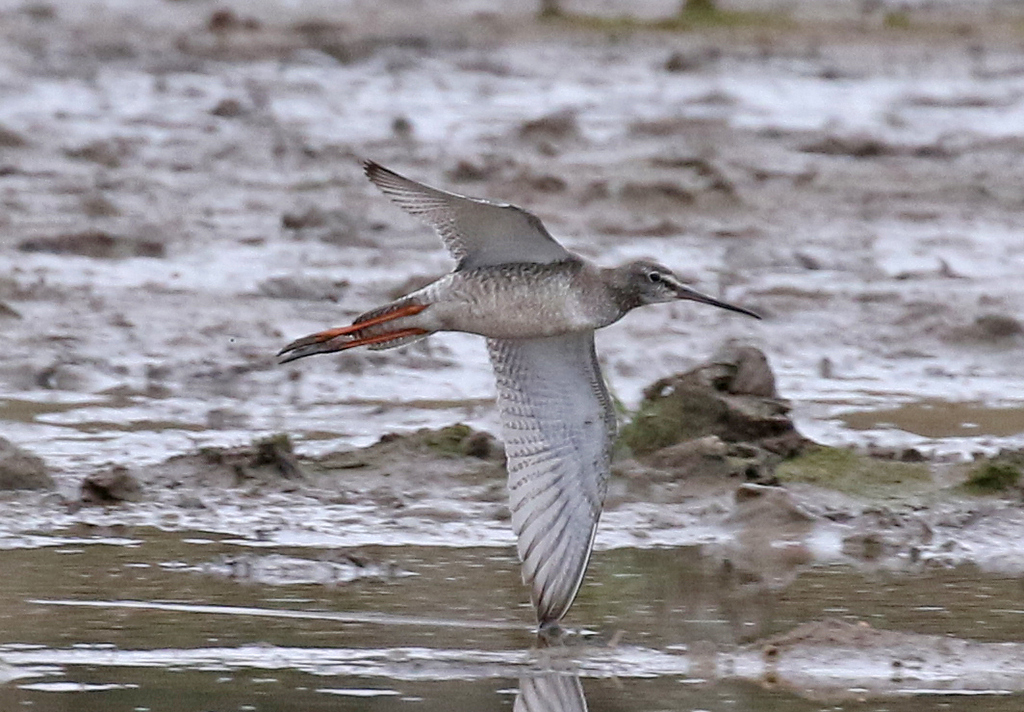
As we continued back to the track, a Great White Egret flew over in front of us. We could see its long dagger-like yellow bill and long black legs and feet trailing behind, and we watched as it dropped down in the reeds at the back of the pool behind the Spoonbills.
Back at the minibus, we stopped quickly to scan the fields. A couple of small birds on the fence halfway across the field were Whinchats. We got the scopes on them and realised there were actually four of them, and they kept dropping down to the ground beyond before coming back up. We could see their pale peachy-orange breasts and well-marked pale superciliums. Migrants stopping off here to feed on their way south to spend the winter in Africa.
Our next destination was Cley. We stopped at the Visitor Centre car park to use the facilities and scan Pat’s Pool from the picnic area. Even though it was distant, we picked up a couple of juvenile Curlew Sandpiper from here. One was feeding in the shallow water with a couple of Dunlin, in and out of the roosting ducks and Lapwings. A larger flock of Dunlin were in the water beyond.
Most of the hides on the reserve remain closed still but Bishop Hide has finally been opened at least, so we decided to head down to try for a closer look. A Cetti’s Warbler shouted at us from the reeds as we walked along the Skirts path. When we turned onto the bridge across the ditch, a couple of people were photographing something down below, so we stopped to look. A Water Vole was busy munching on water lily leaves just a couple of metres away, completely unconcerned at all the attention it was attracting.

Thankfully the hide was fairly empty, so masks on and no problem with social distancing to worry about. We couldn’t see any sign of the Curlew Sandpipers where they had been, although most of the Dunlin were now feeding behind the island where we couldn’t see them. There were lots of Lapwings, several Ruff and Black-tailed Godwits, and two Avocets still, all out in view.
We heard Bearded Tits calling a couple of times from the reeds in front of the hide, but they were keeping well hidden in the breeze today. Amongst the ducks scattered around, several Gadwall were a new addition to the list.
Thankfully, we didn’t have to wait too long for the Curlew Sandpipers to reappear, three of them now, all juveniles. They were busy feeding around the clumps of mud at the back of one of the lower islands. Through the scopes, we could see their longish, decurved bills, pale peachy washed breasts, clear white underparts and neat scaly brown upperparts. Noticeably different to the Dunlin, when you got your eye in.

Curlew Sandpipers breed way up in Central Siberia and winter in Africa. The adults migrate earlier and mostly take a more direct route overland, but many of the juveniles take a more coastal route which brings them to us at this time of year. Amazing to think of the journey these young birds were making, without any input from the adults.
Having had a good look at the Curlew Sandpipers, we decided to make our way back to the Visitor Centre for lunch. On the way back along the path, a tiny Harvest Mouse shot across in front of us and disappeared into the grass the other side.
After lunch, we drove the short distance along to Walsey Hills. A couple of stripy-headed juvenile Little Grebes were continually diving in the water on Snipe’s Marsh and two Green Sandpipers were feeding on the mud beyond, in front of the reeds. A Great Spotted Woodpecker was calling from over towards North Foreland Wood and we looked over at a dead tree on the front edge to see it perched towards the top.
Making our way up along the East Bank, another Little Grebe, an adult this time, was down on Don’s Pool. There were a few Dunlin on the Serpentine and a single Redshank, with a large group of Curlew mostly asleep in the grass beyond.
Suddenly the Curlew all took to the air, calling, and we turned to see a falcon chasing after a small wader in front of Arnold’s Marsh, a Hobby! The Hobby, a young bird and inexperienced, was shaken off by its target fairly quickly. It turned and came fast and low across the grass the other side of the Serpentine, and disappeared inland past us.
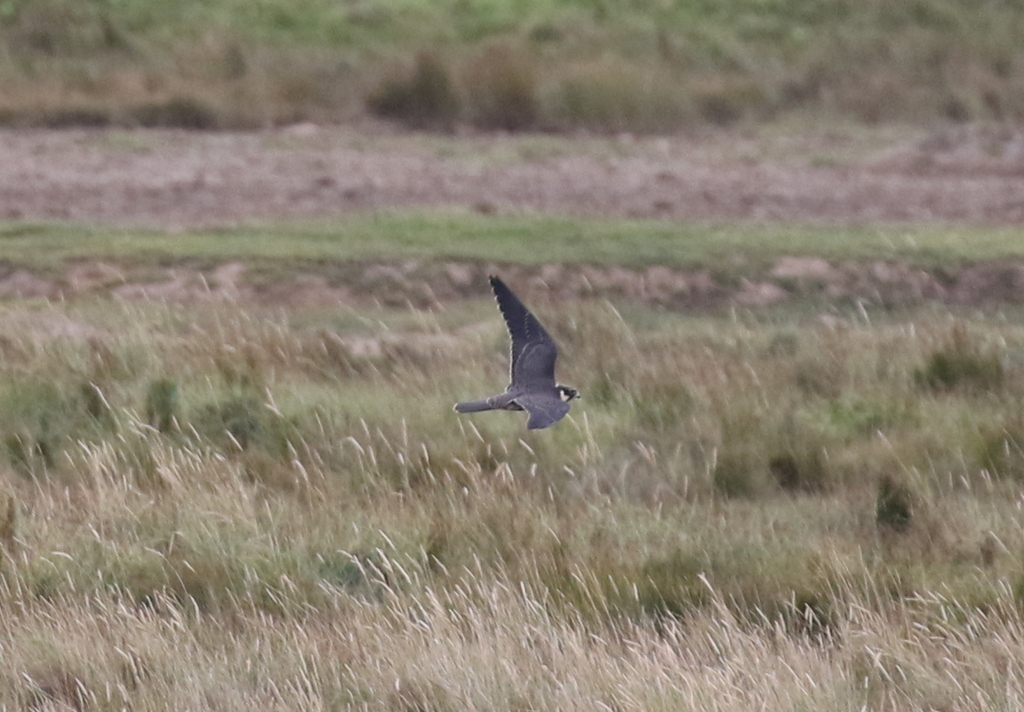
From the shelter overlooking Arnold’s Marsh, we could see lots more Dunlin out in the water. They were very nervous after the Hobby had been through and flew up and whirled round a couple of times. A flash of a white rump in amongst them alerted us to a Curlew Sandpiper and when they finally settled down we could see it through the scopes. Otherwise, there were more Curlew and Redshank here.
A large mob of Sandwich Terns were roosting and preening around a couple of the low shingle islands in the middle, and kept spooking and flying up noisily too. A single Common Tern was in with then initially before deciding to socially isolate on an island of its own. It won’t be long now before all the terns will be leaving us and heading south to warmer climes for the winter.
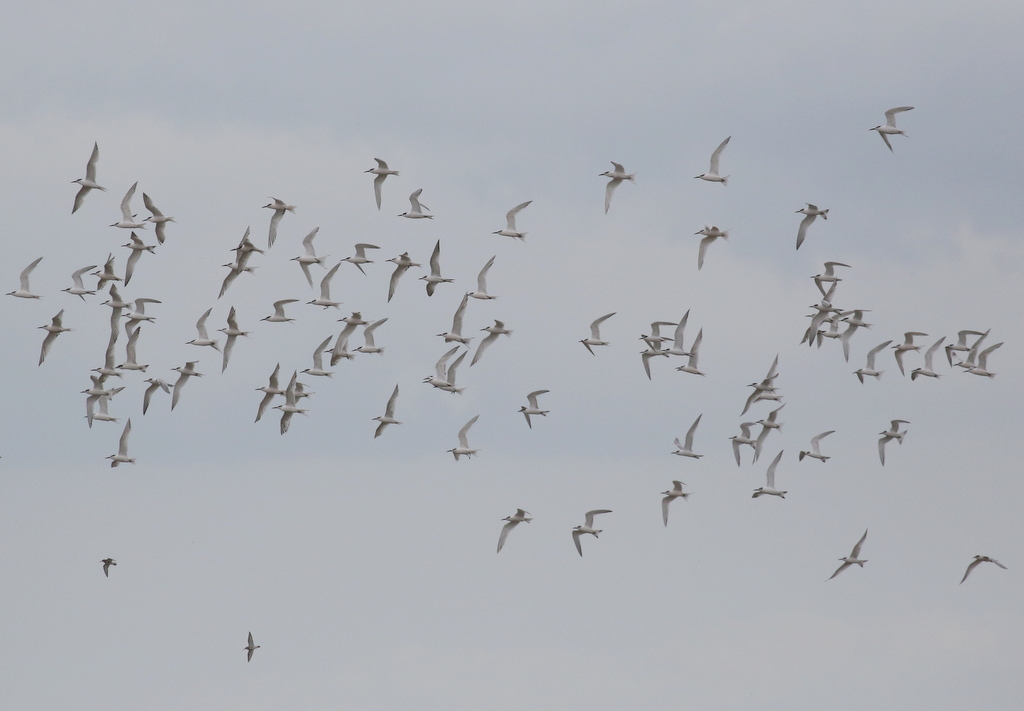
Out at the beach, more Sandwich Terns were feeding offshore. We picked up a few very distant Gannets and one or two Cormorants, but couldn’t see anything else on the sea today. However, a small flock of fifteen Knot did fly past just offshore, presumably migrants just arriving, probably heading for the Wash.
Back at Snipe’s Marsh, a Common Sandpiper had now appeared with the Green Sandpipers. A Wryneck had been reported at Weybourne again this afternoon, but by the sounds of things was very elusive – we didn’t have time to try now, one for tomorrow perhaps. We decided to try instead for the Little Stint which had apparently been reported on North Scrape earlier.
There had been a few Wheatears and Whinchats around Eye Field earlier, but we couldn’t see any from the beach car park. As we walked along the beach towards North Scrape, we came across a couple of people staring into the weedy vegetation on the shingle. They told us that a Wheatear had been seen in here, but they couldn’t find it. It was actually out on the stones just a couple of metres from them! Very tame, we had a great view of it before it disappeared back into the vegetation.
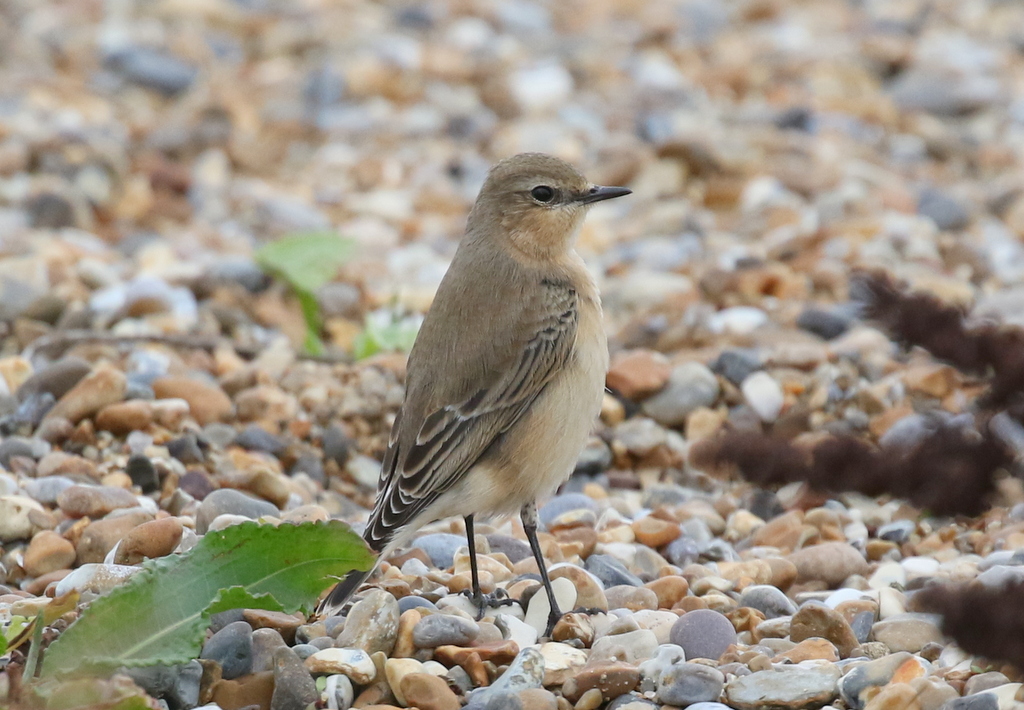
Further on, we came across some Whinchats and another Wheatear along the Eye Field fence. They kept flying on a short distance ahead of us and by the end of the field we had amassed four Whinchats in total. They eventually moved over into the vegetation on the shingle and perched on the tops eyeing us as we passed.
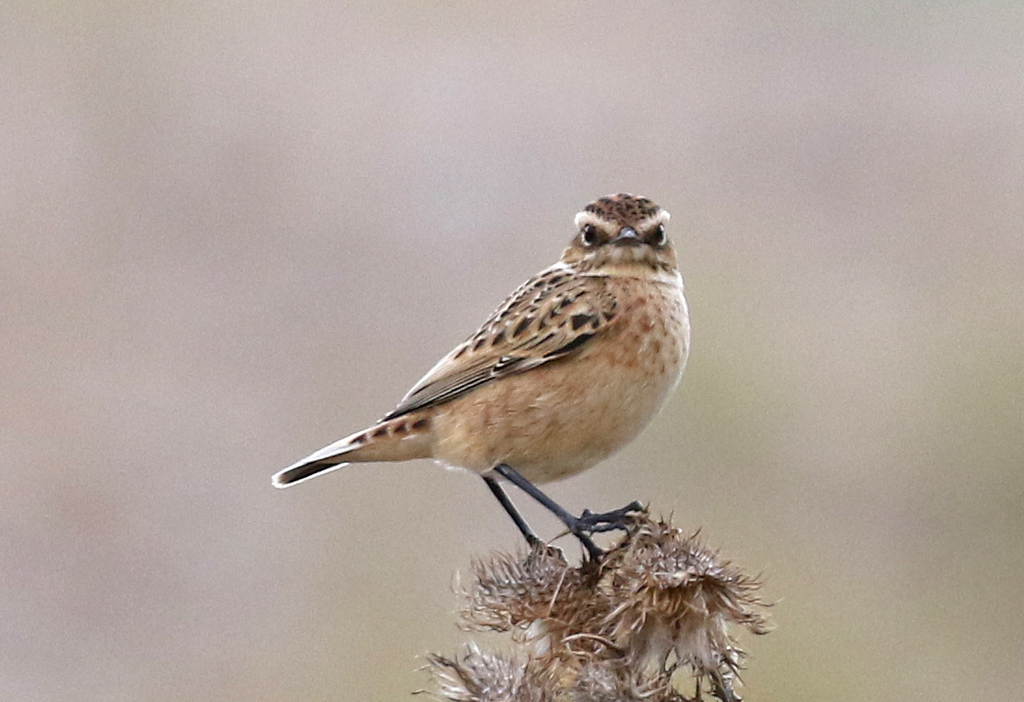
Some movement down in the vegetation on the shingle ahead of us caught our eye and we caught the back end of a family of Weasels as they scuttled into cover.
There was no sign of the Little Stint on North Scrape, but there were lots of Dunlin, a couple of Little Ringed Plovers, a single Greenshank down at the front and a lone Knot. While we were scanning the mud, we heard Whimbrel calling behind us and turned to see three flying in off the sea. They flew in over North Scrape, then turned and flew back out to the sea again, before flying back in once more.
It was time to start heading back now. We had seen a huge group of Red-legged Partridges in a stubble field way off inland as we were sitting at North Scrape – released en masse for shorting. Then as we walked back past Eye Field, a covey of Grey Partridge flew up from the grass close to the fence.
When we heard Whimbrel calling again, we looked over to see three flying in off the sea – hard to tell if they were new birds coming in or the same three we had seen earlier which had for some strange reason gone back out to sea. However, the two Gadwall we picked up coming in over the sea from some way out were certainly fresh arrivals, probably coming in from the continent for the winter.
Always great to see migration in action and a nice way to wrap up our first day.
















